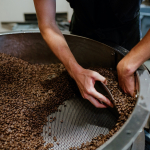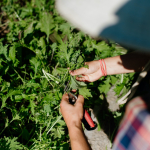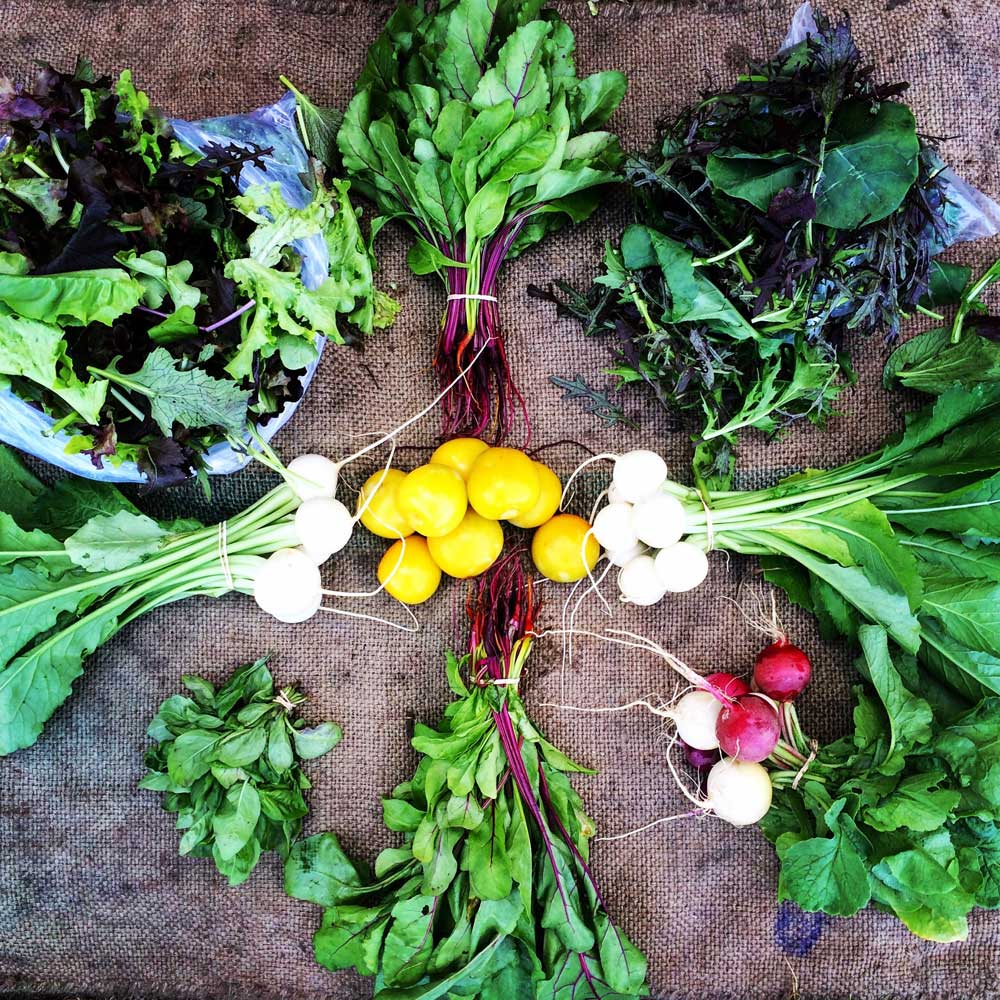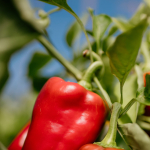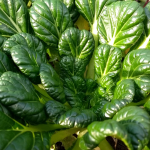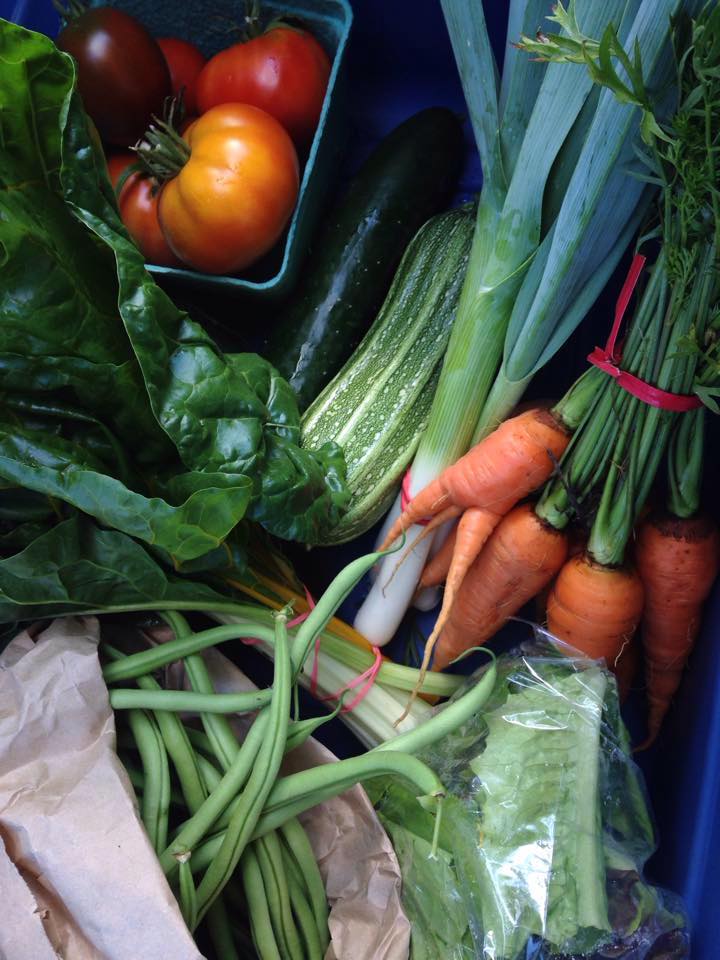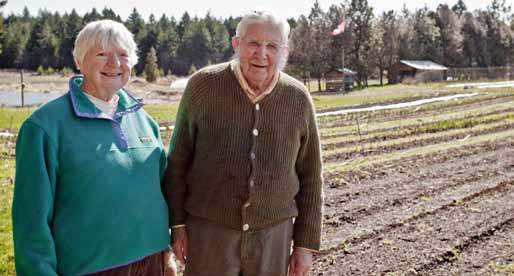Organic Stories: Eatmore Sprouts

From Seedling to Success Story
Moss Dance
If you’ve ever bought a box of sprouts in BC, it’s highly likely that they were grown at Eatmore Sprouts in K’ómox Territory, on Vancouver Island (Courtenay, BC.) Behind that delicious package of sprouts, there is a story of earth-conscious principles, community, and dedication to the organic movement. The story of Eatmore Sprouts is like the life of a germinating seed—but also a lot like the story of the Little Engine That Could.
Carmen Wakeling, co-owner and operator of Eatmore Sprouts, got an early start in growing food. Growing up in the Comox Valley, she says her Mom was an avid gardener, cultivating a garden that supplied the family’s table. At age 15, Carmen started working at Eatmore Sprouts—at the time, it was just “the farm down the road” to her.
Founded in 1975, Eatmore Sprouts was a market garden and a small sprout operation in the early days. Carmen received a lot of mentoring in the garden. The farmer “was a phenomenal grower,” she recalls. “He used French intensive methods, and made his own compost, and I was just amazed you could do all of that.”

Photo: Pea shoot salad. Photo credit: Pamela Powell
Carmen worked at Eatmore Sprouts each summer throughout her teenaged years, and met and married her husband, Glenn, when she was 19years old. Glenn Wakeling grew up on a conventional hill country l farm on the North Island of New Zealand. Carmen remembers how he moved to Canada and saw this ecologically-friendly way of producing food, and was quickly convinced of the benefit of organic principles.
Soon after their marriage, Carmen and Glenn had the opportunity to purchase the Eatmore Sprouts business. They had bought a home in Oyster River a year before hand, just north of Courtenay, and moved the operation to their newly acquired half acre and greenhouse. Glenn was building and Carmen was a nursing student, so both worked part time with the sprouts. Eatmore Sprouts began to germinate in their backyard.
In the early days, Carmen and Glenn worked with incredible drive. They were producing enough product to deliver to Courtenay, Comox, Campbell River, and Nanaimo weekly. They also hired four part-time employees who came in to pack sprouts for shipping. They were so busy, they barely had time to think, but Carmen says, “We didn’t have business background, but then we began to pay attention to money,” she laughs, “because we were wondering, why is there no money?”
“We started to realize it was financially unstable because of the size and the scale of the operation.” says Carmen, so they dropped some product samples off at the Thrifty Foods grocery store in Nanaimo. “Alex Campbell Jr. called us the next day and said they wanted to carry our product in all of the stores on Vancouver Island—this was a big breakthrough for us.”
Interest from a major retailer shifted things substantially for the Wakelings. “We went from part-time growing out of the back shed to a full-time sprout operation,” Carmen says. ” I made a decision to stop nursing school because I realized the healthy food we were producing had a far more long-term and big impact potential for the people that we were feeding.” Scaling up, they were starting to see the financial benefit of the operation. Soon enough, they realized that they were beyond capacity with the facilities they had available.

Photo: Display at the Comox Valley Farmers’ Market. Photo credit: Pamela Powell
At this point, the Wakelings were producing enough to supply all of the Thrifty Foods stores on Vancouver Island plus their existing markets on a half acre lot in a rural neighbourhood. Carmen laughs about the trucks coming in and out at midnight to pick up and drop off. They realized their little sprout of an operation needed to be transplanted to a new facility. They approached a local farmer who had been producing bean sprouts for them to distribute, and they agreed to partner and purchase land together where they could build a bigger facility. They chose their current location on Grieve Rd in Courtenay because it had excellent water, and highway access in an area that was agricultural and business-friendly.
After the move, the Wakelings’ family grew, and as a mother of two young children, Carmen focused her energy on producing special events, and delved into learning more about food safety. In the new facility, they were amazed at all the space they had available—but within two years they were busting at the seams again! They built additions and entered into wider distribution networks, and demand skyrocketed.
It’s an incredible story of exponential growth—Eatmore Sprouts started on half an acre with four employees, and they now operate on a 3.75 acre farm and lease 7 acres from a neighbour. Their operation boasts a state-of-the-art ecological sprouting facility and a two acre market garden. They are also one of the larger agricultural employers in the Comox Valley with around 40 year-round employees.
Business was booming, and the Wakelings had learned through the school of hard knocks about all aspects of the operation, including logistics management, distribution, food safety, and strategic planning. That’s when they decided to restructure the partnership—Carmen and Glenn purchased the business from their partners. It was a huge risk, but the Wakelings had a vision and they wanted to pursue their passion for creating the business in a way that deeply reflected their values.
Carmen says, “We realized that we were sprout producers, we were not distributers, we were not logistics managers, we wanted to grow sprouts and create healthy community. Every year, we learn more. The whole thing is still really exciting to me as I get to learn something new every day.”
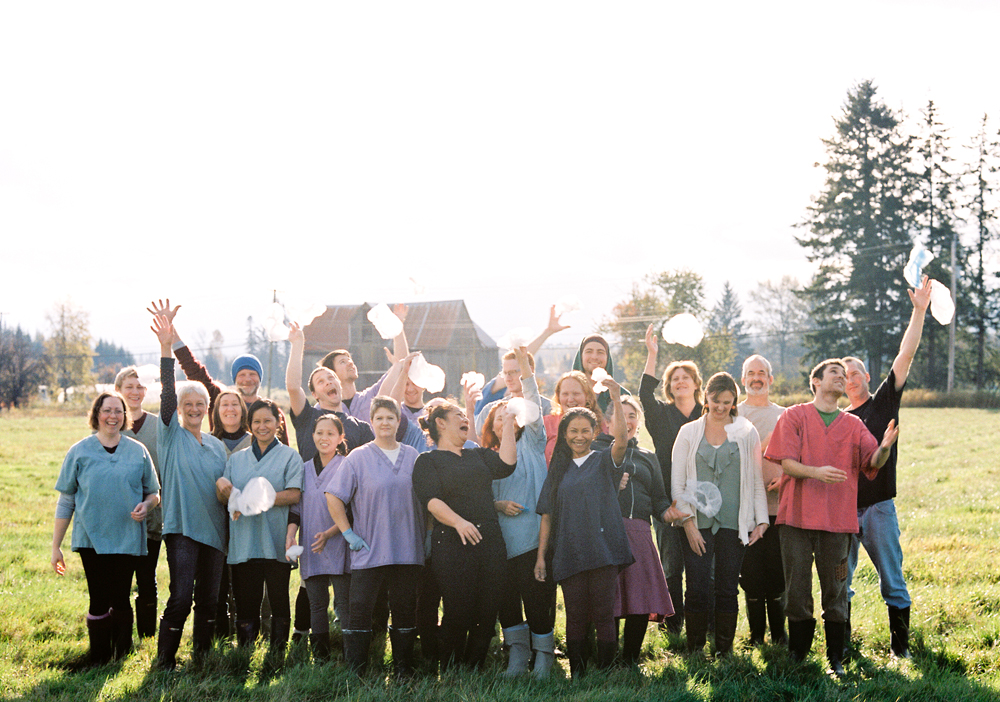
Photo: The Eatmore Sprouts team. Photo credit: Pamela Powell
Ecological Footprint
When asked about Eatmore’s natural wastewater treatment system, wood gasification heater for the pea and sunflower houses, and about their commitment to lowering their ecological footprint, Carmen says, “We’re always talking about it, and we’re always trying to do better, especially Glenn, and my son Robin—they are very focused on this aspect of the business.”
“We own this property, and that makes a big difference, because we can make those deep investments that will be impactful ecologically and financially.” The Wakelings regularly look at the return on investment for each sustainable technology or adaptation they implement on their operation, to ensure that they make financial sense.
“We don’t always take into account the amount of maintenance the technology will require,” says Carmen. For example, the wood gasification heater for the pea and sunflower greenhouses means that Glenn is constantly on the search for firewood in the summer, and is schlepping wood every day in the winter to keep those greenhouses heated.

Photo: The wood gasification heater at Eatmore Sprouts keeps the pea and sunflower houses toast all winter. Photo credit: Pamela Powell
A recent carbon assessment reported that Eatmore Sprouts was “inches away from being carbon neutral,” and that the business would soon be eligible to sell carbon credits back—all they had to do was transition to renewable natural gas, so they did. Carmen would like to go further: “We still use plastic packaging, which none of us like, and we are always searching for alternatives. Our packaging is recycled, and it’s recyclable, and it’s made in Vancouver, so it’s the best we can get—but it’s not ideal.”
“There are parts of this operation that still drive us crazy—bureaucracy continues and paper work is never ending” she continues, “but we try to do everything we can to mitigate those issues. We extract heat out of our processing wastewater which we use to then heat our facility through heat pumps. We are doing everything we can, and we know that we can always do better. We always challenge ourselves to look for better ways to do things sustainably. We want to be the kind of business that shows that change can happen.”

Photo: Solar panels on the roof of the sprouting facility. Photo credit: Pamela Powell
Germinating Organics
The Eatmore Sprouts story has been evolving as the organic movement grows—step by step, the Wakelings have been engaged and involved in the development of standards and the growth of the community for decades.
There was no formal organic movement that they knew about when they first started, but the Wakelings had read about organic farming and principles, and had mentors who were composting, regenerating the soil, and role modelling ecological growing practices. From the beginning, Carmen was firm about her desire to farm without chemical inputs. She feels lucky that in her early agricultural education she learned about composting and healthy soil instead of how to apply chemical fertilizers and pesticides.
While the operation was fairly simple to manage ecologically at the time, Carmen admits that “the hardest thing was that there was no standard to follow.” So when they became aware of the BC organic program, they certified in 1994, and ended up helping to develop the standards for sprouting. Now there is a national standard on sprouting, and the Wakelings contributed a lot to that.
In 1999, the CFIA started to turn its attention to the sprouting industry, and the Wakelings stepped up again, building relationships and helping to develop the food safety standards for organic sprouting operations. The main issue at stake was seed sanitizer recommendations: “at the time, the standard was to apply 20ppm of chlorine to sterilize the seed,” Carmen remembers. “In the U.S., to this day, that is still the only standard that they have for sprout production.” So Carmen got on board with the the International Sprout Growers Association (she’s now the president) and she is advocating for organic sprout growers south of the border to create more organic-friendly standards with the FDA.
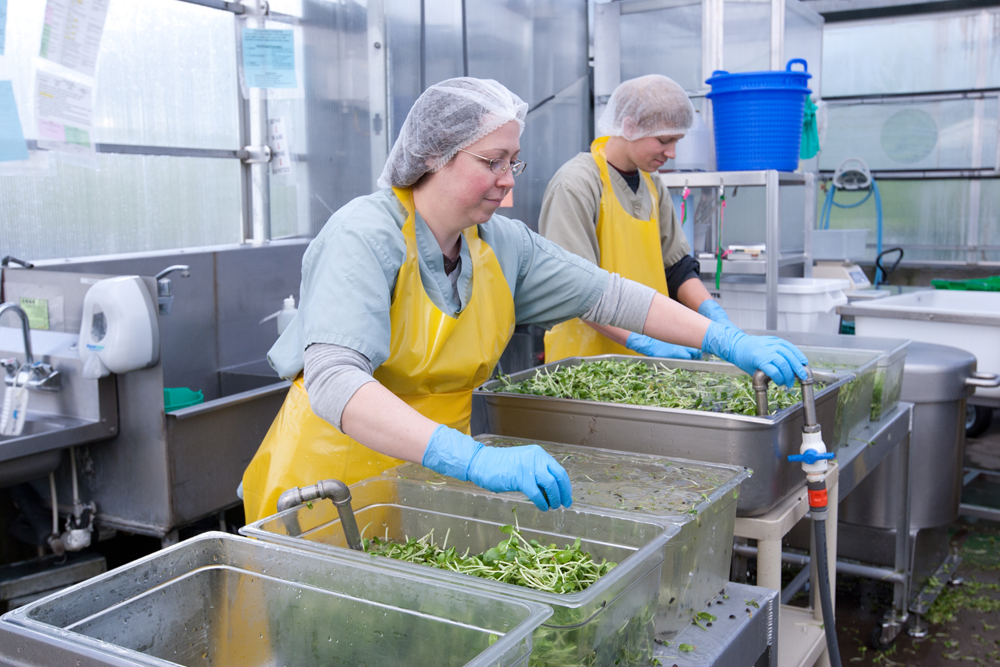
Photo: Washing sunflower shoots. Photo credit: Pamela Powell
Early Days for Organics
Carmen remembers an early Organic Conference in 1998 with the COABC. “We organized a conference for 150-200 organic producers at Tigh-Na-Mara in Parksville on a shoestring budget,” she remembers. “I made platters and platters of lasagne and I baked them in the ovens in the cabins of participants, and we all ate together in the biggest room we had available, just to save money!”
“The willingness to give and share with each other —all these people were showing up and feeding each other and I thought, wow, this is a powerful community.” When Carmen saw Mary Forstbauer’s ‘Checkmark Dance,’ she realized, “these are my people—organic producers are fighters, they’ve had to fight for everything. Their communities thought they were just a bunch of hippies and a bit weird. It was all very grassroots, and it still is very grassroots.”
“Whenever I had a chance to contribute something to the COABC community, I would. I was on the standards review committee for ages, and I got to do the SRC for aquaculture. I got to know so many great people.I always want to contribute however I can to the COABC.” Carmen laughs, “Funnily, now, I’m considered an elder.” Even though she’s far from typical retirement age, Carmen’s experience and knowledge are so extensive, this makes sense. “Right now I’m in this role as president of the organization—but I feel like my main role is as a bridge person.”
“There’s so much brilliance and intelligence amongst the people in the organic sector,” Carmen says. “People are so innovative and creative, and they’ve had to be business people beyond business people, because they’ve had to stand up in community, and also make room for themselves in the business world. Now, it’s a matter of trying to encourage and engage the youth so we can start to plan for succession in the organization. And there are so many people coming on board and it’s just so great to see that happening.”
“There is such amazing energy in this sector. And it’s interesting because you hear that the agriculture sector is not having people show up. Of course, we are not perfect yet. We have not spent enough time on financial sustainability in this sector, we tend to focus more on sustainability of the planet, and community, but we forget that financial piece sometimes.”
Carmen worries about the challenges facing new farmers now: “There are a lot of challenges associated with trying to get into the food game at this stage. I look at what we’ve done and I don’t know if we could have repeated the experience now, because of the cost of everything. It makes me really concerned, and it makes me really value the work that Young Agrarians are doing to link land and farmers and to bring people a level of business acumen so that the people who are showing up really understand what they are getting into.”
“The coolest part about this generational shift that’s happening,” Carmen says, “ is that people are seeing collaboration is essential. It takes a team to climb Mt. Everest. That’s where I see so much hope and benefit for the organic sector and the planet—that younger people are seeing the importance of this.”
“I’m getting older, and I want to eat really well when I’m old. So now I’m thinking about getting farmers on farms, and supporting them to be financially viable.”
Learn more: www.eatmoresprouts.com
Moss Dance is an organic farmer on the search for a new farm on Salt Spring Island, and works with the BC Organic Grower as layout editor. She spent the last decade farming and organizing in K’ómox Territory, and even got to work at Eatmore Sprouts for awhile!
Feature image: Carmen and Glenn Wakeling, owner-operators of Eatmore Sprouts. Photo credit: Pamela Powell


